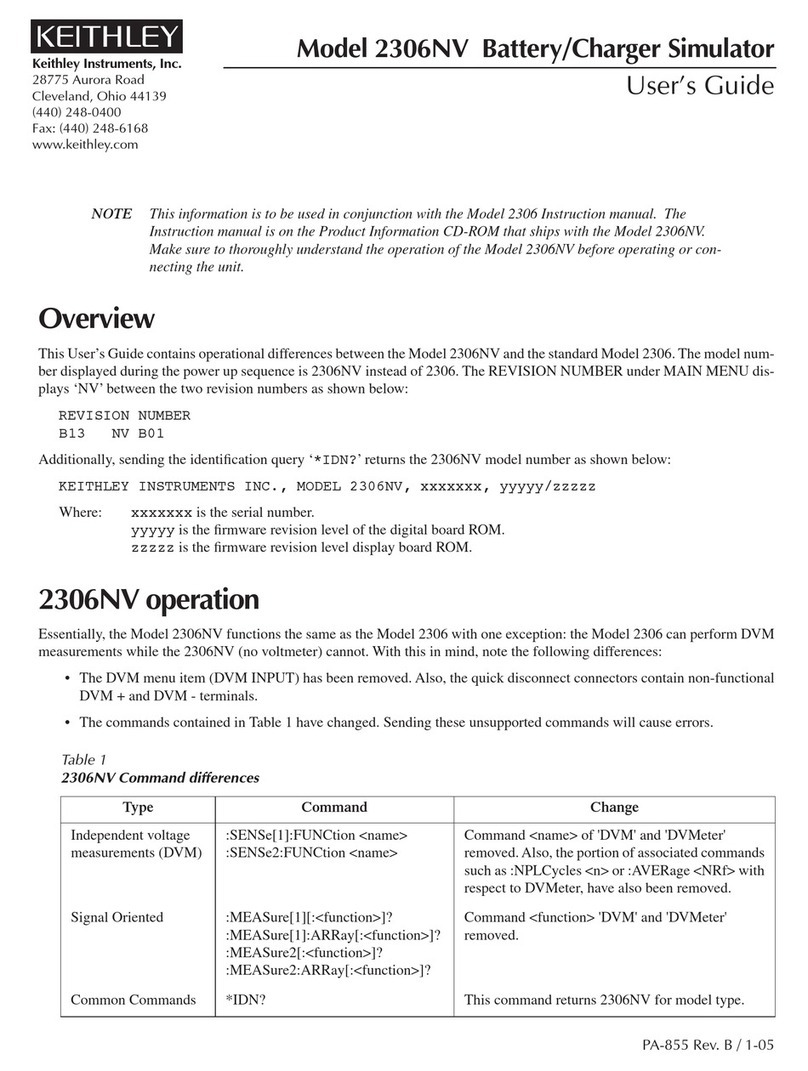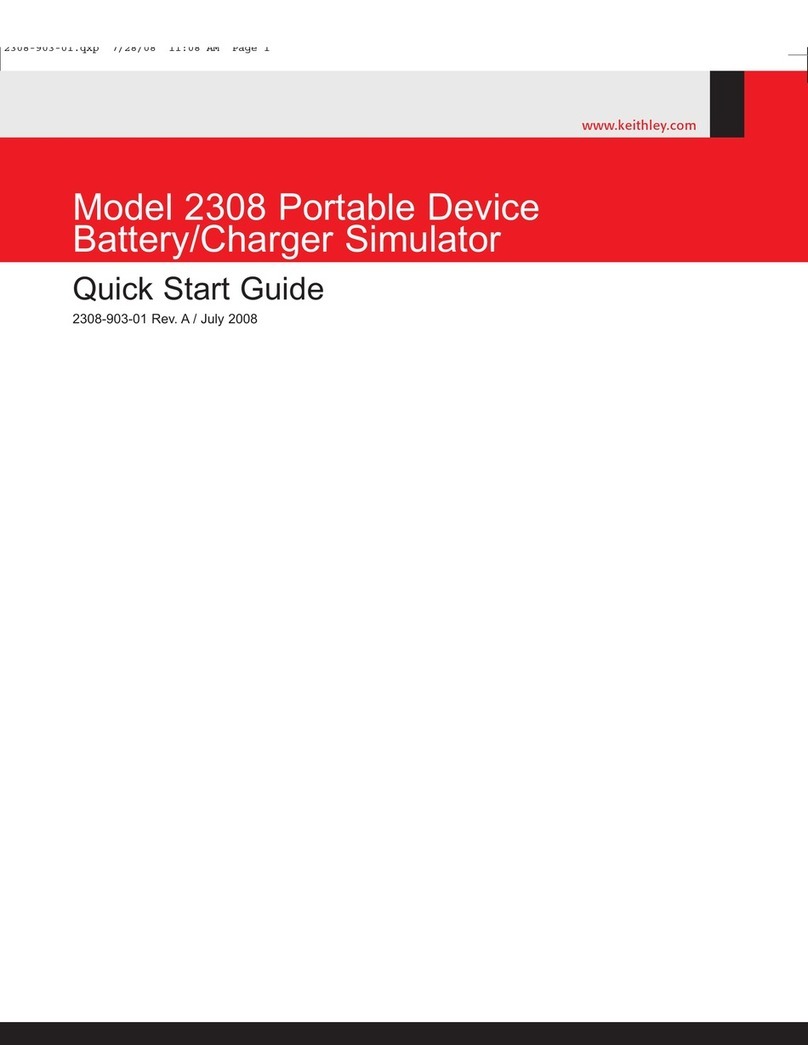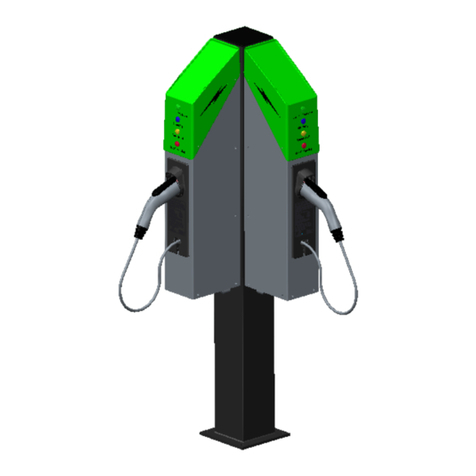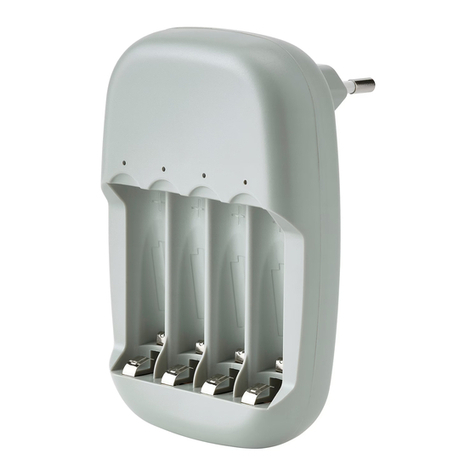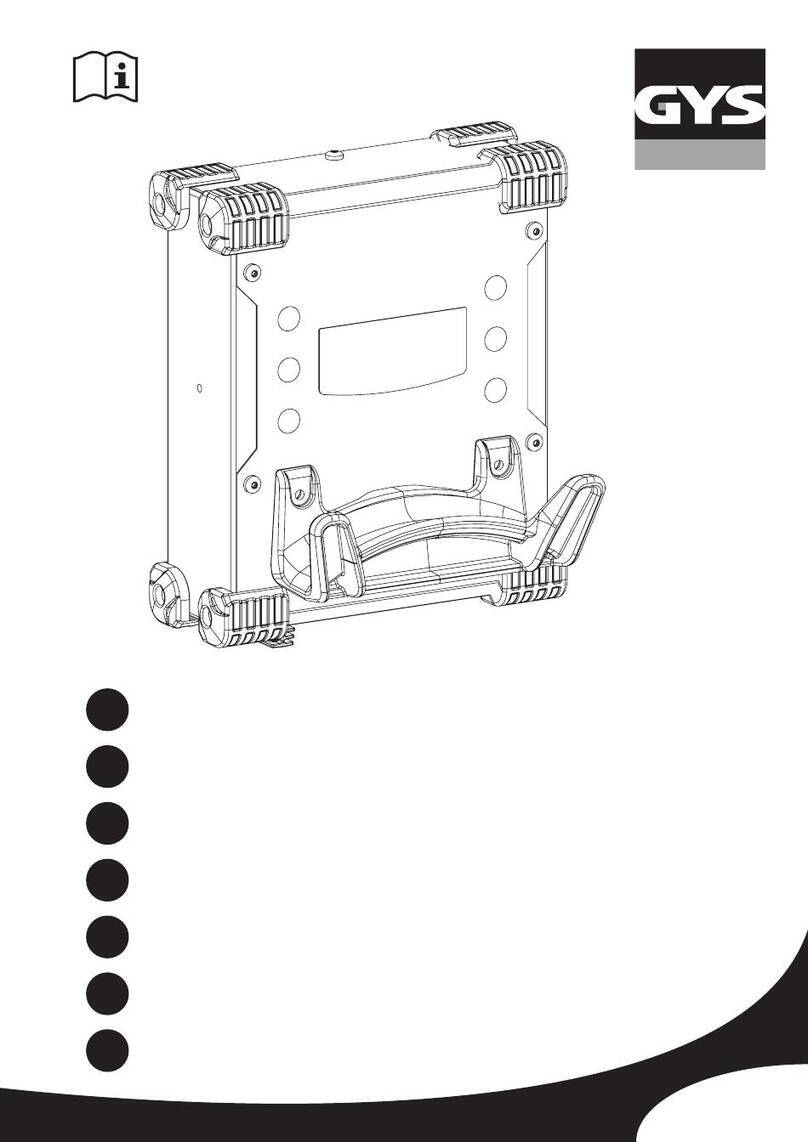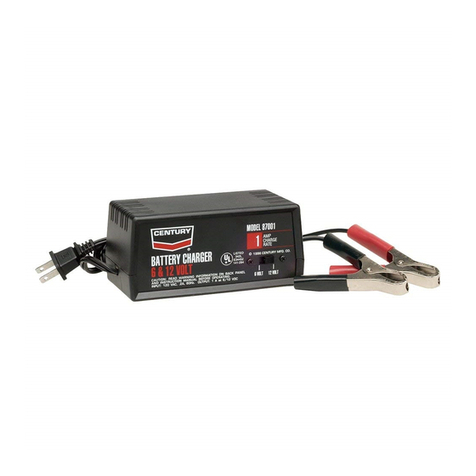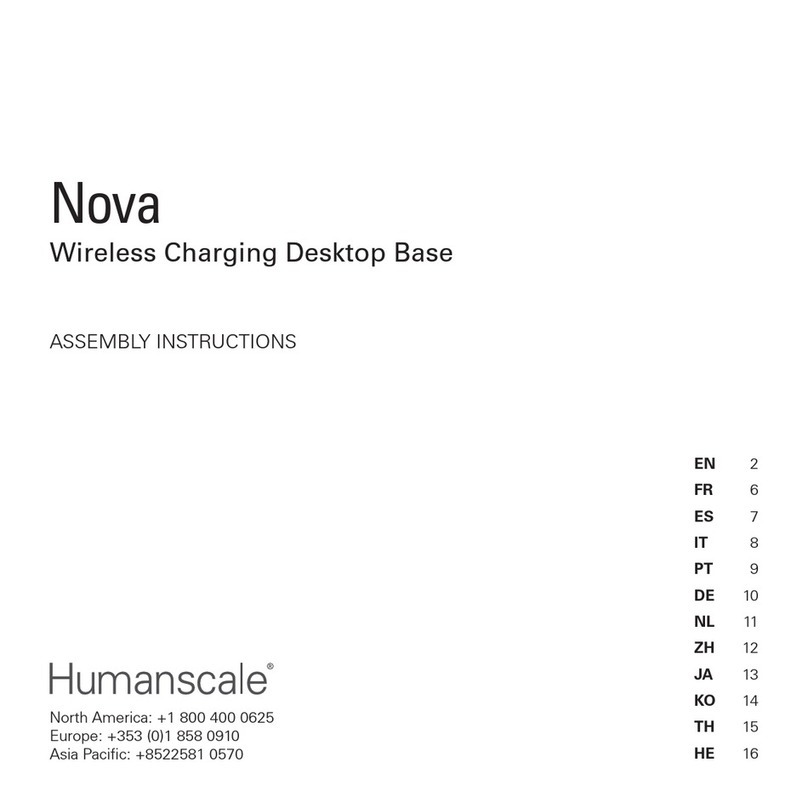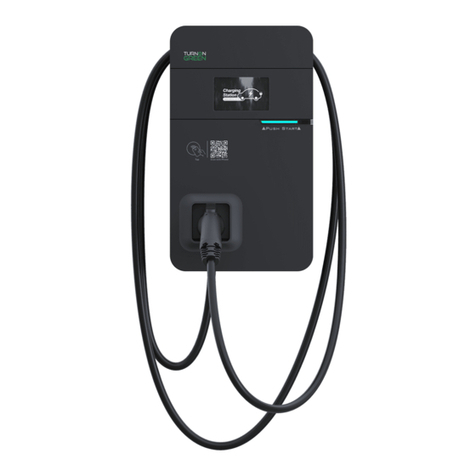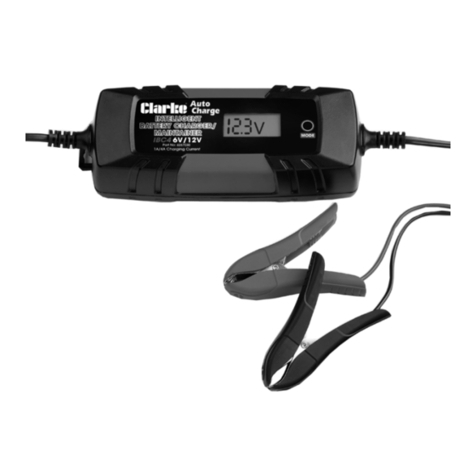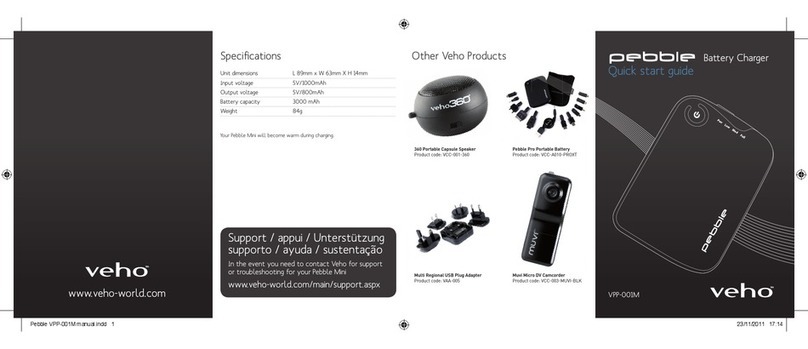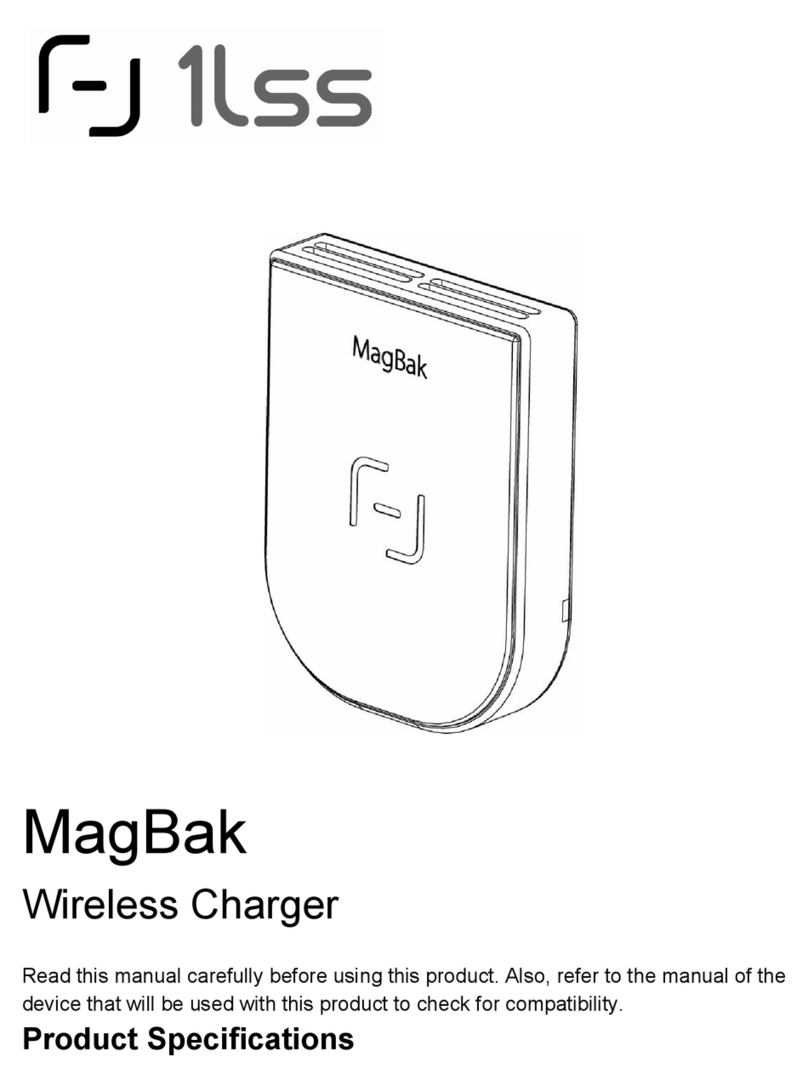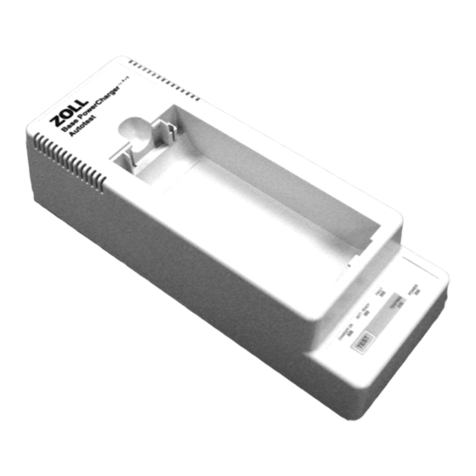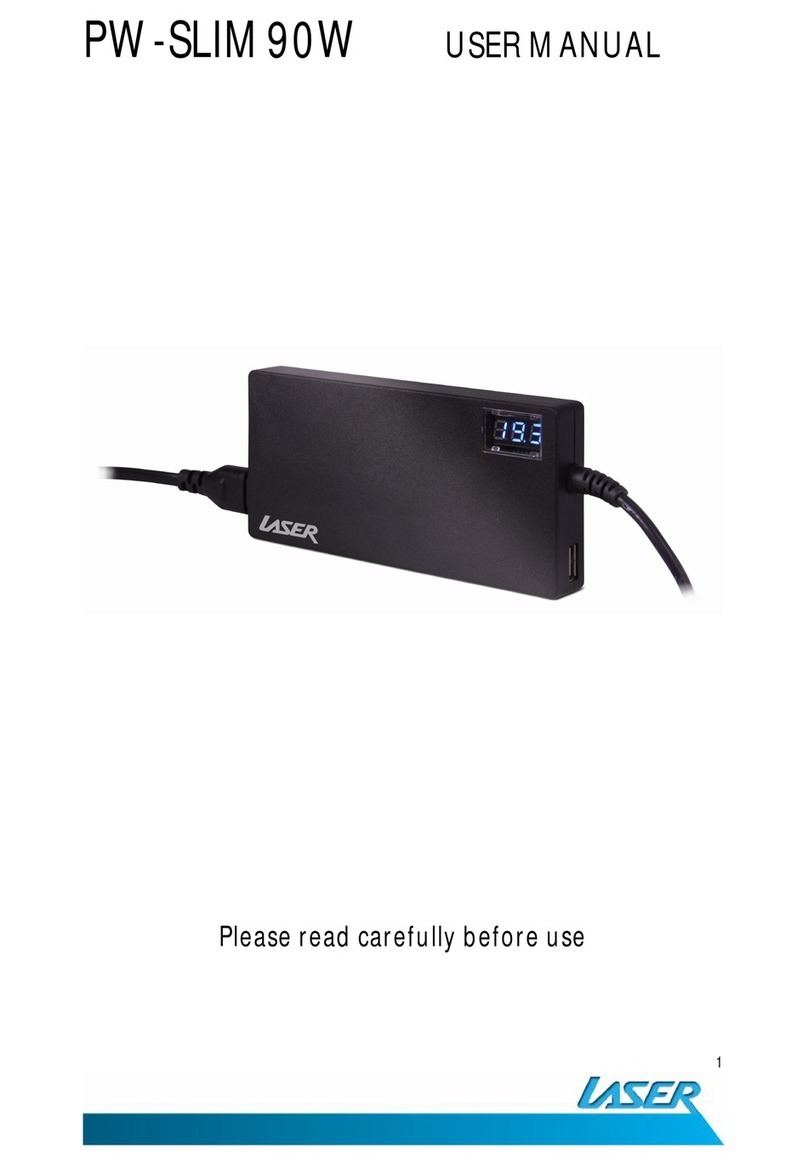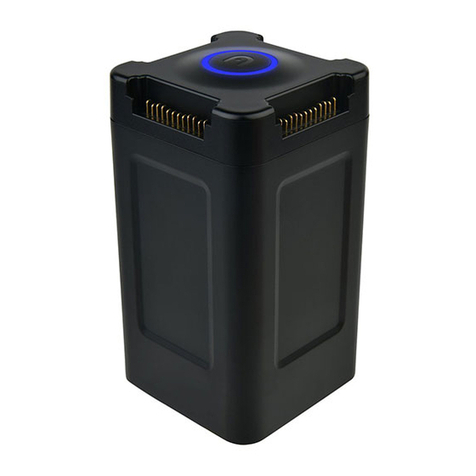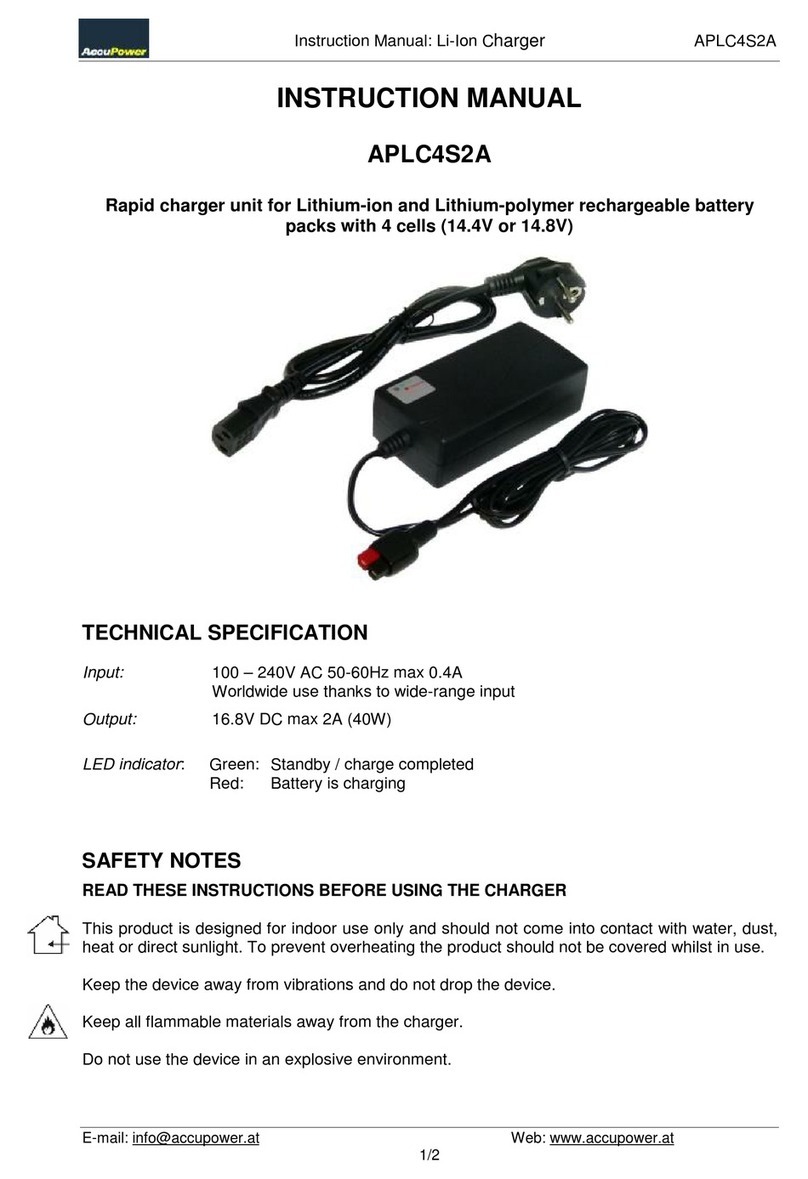Keithley 2302 Operator's manual

Model 2302/2302-PJ/2306/2306-PJ/2306-VS
Battery/Charger Simulator
Quick Results Guide
A GREATER MEASURE OF CONFIDENCE

WARRANTY
Keithley Instruments, Inc. warrants this product to be free from defects in material and workmanship for a
period of 1 year from date of shipment.
Keithley Instruments, Inc. warrants the following items for 90 days from the date of shipment: probes, cables,
rechargeable batteries, diskettes, and documentation.
During the warranty period, we will, at our option, either repair or replace any product that proves to be defective.
To exercise this warranty, write or call your local Keithley representative, or contact Keithley headquarters in
Cleveland, Ohio. You will be given prompt assistance and return instructions. Send the product, transportation
prepaid, to the indicated service facility. Repairs will be made and the product returned, transportation prepaid.
Repaired or replaced products are warranted for the balance of the original warranty period, or at least 90 days.
LIMITATION OF WARRANTY
This warranty does not apply to defects resulting from product modification without Keithley’s express written
consent, or misuse of any product or part. This warranty also does not apply to fuses, software, non-rechargeable
batteries, damage from battery leakage, or problems arising from normal wear or failure to follow instructions.
THIS WARRANTY IS IN LIEU OF ALL OTHER WARRANTIES, EXPRESSED OR IMPLIED, INCLUD-
ING ANY IMPLIED WARRANTY OF MERCHANTABILITY OR FITNESS FOR A PARTICULAR USE.
THE REMEDIES PROVIDED HEREIN ARE BUYER’S SOLE AND EXCLUSIVE REMEDIES.
NEITHER KEITHLEY INSTRUMENTS, INC. NOR ANY OF ITS EMPLOYEES SHALL BE LIABLE FOR
ANY DIRECT, INDIRECT, SPECIAL, INCIDENTAL OR CONSEQUENTIAL DAMAGES ARISING OUT OF
THE USE OF ITS INSTRUMENTS AND SOFTWARE EVEN IF KEITHLEY INSTRUMENTS, INC., HAS
BEEN ADVISED IN ADVANCE OF THE POSSIBILITY OF SUCH DAMAGES. SUCH EXCLUDED DAM-
AGES SHALL INCLUDE, BUT ARE NOT LIMITED TO: COSTS OF REMOVAL AND INSTALLATION,
LOSSES SUSTAINED AS THE RESULT OF INJURY TO ANY PERSON, OR DAMAGE TO PROPERTY.
Keithley Instruments, Inc.
28775 Aurora Road • Cleveland, Ohio 44139 • 440-248-0400 • Fax: 440-248-6168
1-888-KEITHLEY (534-8453) • www.keithley.com
Sales Offices:
BELGIUM:
Bergensesteenweg 709 • B-1600 Sint-Pieters-Leeuw • 02-363 00 40 • Fax: 02-363 00 64
CHINA:
Yuan Chen Xin Building, Room 705 • 12 Yumin Road, Dewai, Madian • Beijing 100029 • 8610-82251886 • Fax: 8610-82251892
FINLAND:
Halsuantie 2 • 00420 Helsinki, Finland • 09-53 06 65 60 • Fax: 09-53 06 65 65
FRANCE:
3, allée des Garays • 91127 Palaiseau Cédex • 01-64 53 20 20 • Fax: 01-60 11 77 26
GERMANY:
Landsberger Strasse 65 • 82110 Germering • 089-84 93 07-40 • Fax: 089-84 93 07-34
GREAT BRITAIN:
Unit 2 Commerce Park, Brunel Road • Theale, Berkshire RG7 4AB • 0118 -929 75 00 • Fax: 0118- 929 75 19
INDIA:
1/5, Eagles Street • Langford Town • Bangalore 560 025 • 080 212 80-27 • Fax: 080 212 80 05
ITALY:
Viale San Gimignano, 38 • 20146 Milano • 02-48 39 16 01 • Fax: 02-48 30 22 74
JAPAN:
New Pier Takeshiba North Tower 13F • 11-1, Kaigan 1-chome • Minato-ku, Tokyo 105-0022 • 81-3-5733-7555 • Fax: 81-3-5733-7556
KOREA:
2FL., URI Building • 2-14 Yangjae-Dong • Seocho-Gu, Seoul 137-888 • 82-2-574-7778 • Fax: 82-2-574-7838
NETHERLANDS:
Postbus 559 • 4200 AN Gorinchem • 0183-63 53 33 • Fax: 0183-63 08 21
SWEDEN:
c/o Regus Business Centre • Frosundaviks Allé 15, 4tr • 16970 Solna • 08-50 90 46 00 • Fax: 08-655 26 10
TAIWAN:
13F-3, NO. 6, Lane 99, Pu-Ding Road, Hsinchu, Taiwan, ROC. • 886-3-572-9077 • Fax: 886-3-572-9031
5/03

Model 2302/2302-PJ/2306/2306-PJ/2306-VS
Battery/Charger Simulator
Quick Results Guide
©1999, Keithley Instruments, Inc.
All rights reserved.
Cleveland, Ohio, U.S.A.
Third Printing, June 2003
Document Number: 2306-903-01 Rev. C

Manual Print History
The print history shown below lists the printing dates of all Revisions and Addenda created
for this manual. The Revision Level letter increases alphabetically as the manual undergoes sub-
sequent updates. Addenda, which are released between Revisions, contain important change in-
formation that the user should incorporate immediately into the manual. Addenda are numbered
sequentially. When a new Revision is created, all Addenda associated with the previous Revision
of the manual are incorporated into the new Revision of the manual. Each new Revision includes
a revised copy of this print history page.
Revision A (Document Number 2306-903-01) ............................................................. March 1999
Revision B (Document Number 2306-903-01) ................................................................ May 2000
Revision C (Document Number 2306-903-01) ................................................................ June 2003
All Keithley product names are trademarks or registered trademarks of Keithley Instruments, Inc.
Other brand names are trademarks or registered trademarks of their respective holders.

The following safety precautions should be observed before using this product and any associated instrumentation. Although
some instruments and accessories would normally be used with non-hazardous voltages, there are situations where hazardous
conditions may be present.
This product is intended for use by qualified personnel who recognize shock hazards and are familiar with the safety precautions
required to avoid possible injury. Read and follow all installation, operation, and maintenance information carefully before us-
ing the product. Refer to the manual for complete product specifications.
If the product is used in a manner not specified, the protection provided by the product may be impaired.
The types of product users are:
Responsible body
is the individual or group responsible for the use and maintenance of equipment, for ensuring that the equip-
ment is operated within its specifications and operating limits, and for ensuring that operators are adequately trained.
Operators
use the product for its intended function. They must be trained in electrical safety procedures and proper use of the
instrument. They must be protected from electric shock and contact with hazardous live circuits.
Maintenance personnel
perform routine procedures on the product to keep it operating properly, for example, setting the line
voltage or replacing consumable materials. Maintenance procedures are described in the manual. The procedures explicitly state
if the operator may perform them. Otherwise, they should be performed only by service personnel.
Service personnel
are trained to work on live circuits, and perform safe installations and repairs of products. Only properly
trained service personnel may perform installation and service procedures.
Keithley products are designed for use with electrical signals that are rated Measurement Category I and Measurement Category
II, as described in the International Electrotechnical Commission (IEC) Standard IEC 60664. Most measurement, control, and
data I/O signals are Measurement Category I and must not be directly connected to mains voltage or to voltage sources with
high transient over-voltages. Measurement Category II connections require protection for high transient over-voltages often
associated with local AC mains connections. Assume all measurement, control, and data I/O connections are for connection to
Category I sources unless otherwise marked or described in the Manual.
Exercise extreme caution when a shock hazard is present. Lethal voltage may be present on cable connector jacks or test fixtures.
The American National Standards Institute (ANSI) states that a shock hazard exists when voltage levels greater than 30V RMS,
42.4V peak, or 60VDC are present.
A good safety practice is to expect that hazardous voltage is present in any unknown
circuit before measuring.
Operators of this product must be protected from electric shock at all times. The responsible body must ensure that operators
are prevented access and/or insulated from every connection point. In some cases, connections must be exposed to potential
human contact. Product operators in these circumstances must be trained to protect themselves from the risk of electric shock.
If the circuit is capable of operating at or above 1000 volts,
no conductive part of the circuit may be exposed.
Do not connect switching cards directly to unlimited power circuits. They are intended to be used with impedance limited
sources. NEVER connect switching cards directly to AC mains. When connecting sources to switching cards, install protective
devices to limit fault current and voltage to the card.
Before operating an instrument, make sure the line cord is connected to a properly grounded power receptacle. Inspect the
connecting cables, test leads, and jumpers for possible wear, cracks, or breaks before each use.
When installing equipment where access to the main power cord is restricted, such as rack mounting, a separate main input
power disconnect device must be provided, in close proximity to the equipment and within easy reach of the operator.
For maximum safety, do not touch the product, test cables, or any other instruments while power is applied to the circuit under
test. ALWAYS remove power from the entire test system and discharge any capacitors before: connecting or disconnecting
S
afety Precautions
5/03

cables or jumpers, installing or removing switching cards, or making internal changes, such as installing or removing jumpers.
Do not touch any object that could provide a current path to the common side of the circuit under test or power line (earth) ground.
Always make measurements with dry hands while standing on a dry, insulated surface capable of withstanding the voltage being
measured.
The instrument and accessories must be used in accordance with its specifications and operating instructions or the safety of the
equipment may be impaired.
Do not exceed the maximum signal levels of the instruments and accessories, as defined in the specifications and operating
information, and as shown on the instrument or test fixture panels, or switching card.
When fuses are used in a product, replace with same type and rating for continued protection against fire hazard.
Chassis connections must only be used as shield connections for measuring circuits, NOT as safety earth ground connections.
If you are using a test fixture, keep the lid closed while power is applied to the device under test. Safe operation requires the use
of a lid interlock.
If a screw is present, connect it to safety earth ground using the wire recommended in the user documentation.
The symbol on an instrument indicates that the user should refer to the operating instructions located in the manual.
The symbol on an instrument shows that it can source or measure 1000 volts or more, including the combined effect of
normal and common mode voltages. Use standard safety precautions to avoid personal contact with these voltages.
The symbol indicates a connection terminal to the equipment frame.
The
WARNING
heading in a manual explains dangers that might result in personal injury or death. Always read the associated
information very carefully before performing the indicated procedure.
The
CAUTION
heading in a manual explains hazards that could damage the instrument. Such damage may invalidate the
warranty.
Instrumentation and accessories shall not be connected to humans.
Before performing any maintenance, disconnect the line cord and all test cables.
To maintain protection from electric shock and fire, replacement components in mains circuits, including the power transformer,
test leads, and input jacks, must be purchased from Keithley Instruments. Standard fuses, with applicable national safety
approvals, may be used if the rating and type are the same. Other components that are not safety related may be purchased from
other suppliers as long as they are equivalent to the original component. (Note that selected parts should be purchased only
through Keithley Instruments to maintain accuracy and functionality of the product.) If you are unsure about the applicability
of a replacement component, call a Keithley Instruments office for information.
To clean an instrument, use a damp cloth or mild, water based cleaner. Clean the exterior of the instrument only. Do not apply
cleaner directly to the instrument or allow liquids to enter or spill on the instrument. Products that consist of a circuit board with
no case or chassis (e.g., data acquisition board for installation into a computer) should never require cleaning if handled accord-
ing to instructions. If the board becomes contaminated and operation is affected, the board should be returned to the factory for
proper cleaning/servicing.
!

Table of Contents
Introduction ................................................................................... 2
Performance features ..................................................................... 3
Proper connection of the supply to the DUT ................................ 4
Front panel operation .................................................................... 6
Menu controls ........................................................................ 6
Setting the output voltage, current range, and current limit .. 7
Turning supply output ON/OFF ............................................. 7
Actual V and I mode .............................................................. 7
DVM input mode ................................................................. 10
Pulse current mode ............................................................... 10
Long integration mode ......................................................... 18
Advanced features ....................................................................... 22
Simulating battery impedance .............................................. 22
Variable output bandwidth ................................................... 28
External triggering ............................................................... 29
List of Illustrations
Figure 1 Model 2306 front panel.............................................................. 2
Figure 2 Rear panel view of Model 2306 and 2306-PJ............................ 4
Figure 3 Rear panel view of Model 2306-VS .......................................... 5
Figure 4 4-wire remote sense connection of the DUT to the output ........ 5
Figure 5 2-wire local sense connection of the DUT to the output ........... 6
Figure 6 Pulsed waveform...................................................................... 11
Figure 7 Eliminating the effect of a current transient on a
pulse current measurement................................................. 12
Figure 8 Circuit — determining the dynamic voltage and
current characteristics of a DUT ........................................ 15
Figure 9 Pulsed waveform ..................................................................... 18
Figure 10 Battery schematic..................................................................... 22
Figure 11 Actual battery pack terminal voltage during
GSM phone simulation ...................................................... 23
Figure 12 Simulated GSM phone current profile..................................... 24
Figure 13 Electronic resistance of NiCd, NiMH, and
Li ion battery packs............................................................ 25
Figure 14 Effect of variable output impedance control............................ 26
Figure 15 Voltage drop sample (with supplied Li ion battery pack) ....... 27
Figure 16 Voltage drop sample (with Model 2306 and
output impedance set at 0.24
Ω
) ......................................... 28
Figure 17 Typical trigger sequence.......................................................... 29


Model 2306
Quick Results Guide
NOTE
This quick results guide provides information on five different models of battery or
battery/charger simulators (Models 2302, 2302-PJ, 2306, 2306-PJ, and 2306-VS).
In this guide, references to Model 2306 apply to all of the simulators unless
otherwise noted. Likewise, references to specific models (for example, Model 2306,
2306-PJ, or 2306-VS, or Model 2302 or 2302-PJ) refer only to the models listed.
Since the Model 2302 and 2302-PJ are single channel battery simulators, functions
related to the second channel (i.e., the charger channel) are not available for these
models. Therefore:
• battery and charger channel features contained in this manual apply for
the Models 2306, 2306-PJ, and 2306-VS
• only battery channel features contained in this manual apply for the
Models 2302 and 2302-PJ
References to the Model 2302 also apply to the Model 2302-PJ unless otherwise
noted. Refer to Appendix F of Instruction Manual (2306-901-01) for specific
Model 2302 and 2302-PJ information.
Information contained in this guide applies to all power supply channels (unless
otherwise noted). In this manual, channel 1 refers to the battery channel while
channel 2 refers to the charger channel (2306, 2306-PJ, and 2306-VS features only).
For additional information on any feature discussed in this guide (including
programming examples), refer to the Instruction Manual (part number
2306-901-00).

2 Introduction
Introduction
This guide is designed to familiarize users of the Keithley Model 2306 Dual Channel Battery/
Charger Simulator and Model 2302 Single Channel Battery Simulator with the basic operating
features available from the instrument’s front panel and also the GPIB bus. The sequence of
operating instructions reflects the order in which the instrument would be configured for a
typical application. For each operating mode, an example set of bus commands is provided.
While the SCPI command strings are generic, the exact programming syntax will depend on the
test program language.
Figure 1
Model 2306 front panel
POWER
DISPLAY
OPERATE
ENTER SET
MENU
LOCAL
2306 DUAL CHANNEL BATTERY/CHARGER SIMULATOR

Introduction 3
Performance features
The battery channel, the single output channel of the Model 2302 and channel #1 on the
Model 2306, has several enhanced performance features:
1. The transient response, defined by the voltage recovery time and voltage drop when
subjected to a 1000% load change, is faster. For exact specifications, refer to Appendix A
in the Model 2306 Instruction Manual.
2. Three current trigger ranges for pulsed current and long integration operation as opposed
to a single range on the charger channel, channel #2 (5A). Available trigger ranges for the
5A current range: 100mA, 1A, and 5A. Available trigger ranges for the 500mA current
range (Model 2306-PJ and 2302-PJ): 10mA, 100mA, and 500mA.
3. Variable output impedance on channel #1 (0
Ω
to 1.00
Ω
in 0.01
Ω
steps). Channel #2 has
fixed output impedance.

4 Proper connection of the supply to the DUT
Proper connection of the supply to the DUT
WARNING
When installing a unit into a test system, make sure the external power
sources do not apply voltage to the power supply in excess of its maximum
limits (see specifications). Failure to do so could result in personal injury or
death.
WARNING
The power cord supplied with the Model 2306 contains a separate ground
for use with grounded outlets. When proper connections are made,
instrument chassis is connected to power line ground through the ground
wire in the power cord. Failure to use a grounded outlet may result in
personal injury or death due to electric shock.
Figure 2 shows a rear panel view of the Models 2306 and 2306-PJ detailing the connector
sockets for the battery channel “OUTPUT #1” and the charger channel “OUTPUT #2.” Figure 3
shows the rear panel of the Model 2306-VS. The Model 2306 does not have an internal local
sense connection. Therefore, the operator must connect the DUT to the supply in either a remote
or local sense configuration as illustrated. For a 4-wire remote sense application, the sense inputs
to the supply must be connected at load as close to the inputs of the load as possible through
twisted pair leads as shown in Figure 4.
Figure 2
Rear panel view of Model 2306 and 2306-PJ
WARNING:
NO INTERNAL OPERATOR SERVICABLE PARTS,SERVICE BY QUALIFIED PERSONNEL ONLY.
WARNING:
NO INTERNAL OPERATOR SERVICABLE PARTS,SERVICE BY QUALIFIED PERSONNEL ONLY.
CAUTION:
FOR CONTINUED PROTECTION AGAINST FIRE HAZARD,REPLACE FUSE WITH SAME TYPE AND RATING.
CAUTION:
FOR CONTINUED PROTECTION AGAINST FIRE HAZARD,REPLACE FUSE WITH SAME TYPE AND RATING.
MADE IN
U.S.A.
LINE RATING
100-120VAC, 200-240VAC
50, 60 HZ 150VA MAX.
LINE FUSE
SLOWBLOW
2.0A, 250V
IEEE-488
(ENTER IEEE ADDRESS
FROM FRONT PANEL MENU)
REMOTE
DISPLAY
OPTION
+++
____+
SOURCE SENSE DVM IN
SOURCE
OUTPUT #1
ISOLATION FROM EARTH: 22 VOLTS MAX.
RELAY
CONTROL
24VDC MAX.
+++
____+
SOURCE SENSE DVM IN
SOURCE
OUTPUT #2
DVM IN
+30 VDC MAX.
CAT
I

Proper connection of the supply to the DUT 5
Figure 3
Rear panel view of Model 2306-VS
NOTE
The TRIGGER connectors on the rear panel of the Model 2306-VS are associated
with the external triggering and voltage stepping capabilities of the unit. See
"External triggering" on page 29 and Section 6 of the Model 2306 Instruction
Manual for details.
Figure 4
4-wire remote sense connection of the DUT to the output
NOTE
DO NOT jumper the sense inputs and supply outputs at the rear of the supply.
DO NOT pass the source and sense leads together in the same twisted pair.
WARNING:NO INTERNAL OPERATOR SERVICABLE PARTS,SERVICE BY QUALIFIED PERSONNEL ONLY.
CAUTION:FOR CONTINUED PROTECTION AGAINST FIRE HAZARD,REPLACE FUSE WITH SAME TYPE AND RATING.
MADE IN
U.S.A.
LINE RATING
100-120VAC,
200-240VAC
50, 60 HZ
150VA MAX.
LINE FUSE
SLOWBLOW
2.0A, 250V
IEEE-488
+++
____+
DVM IN
OUTPUT #2
SOURCE SENSE SOURCE
+++
____+
DVM IN
OUTPUT #1
SOURCE SENSE SOURCE
ISOLATION FROM EARTH: 22 VOLTS MAX.
DVM IN
+30 VDC MAX.
TRIGGER
CAT I
IN OUT IN OUT
CHANNEL 1 CHANNEL 2
External Test Circuit
Quick Disconnect
Connector
Model 2306
source input/output
DVM input
DUT
+
-
DVM +
DVM -
Source -
Source -
Sense -
Sense +
Source +
Source +
Twisted pair

6 Front panel operation
Failure to connect the sense leads in this fashion will
severely
compromise the performance
of Model 2306 with dynamic loads. Figure 5 illustrates the proper connection of the supply to
the DUT using a 2-wire local sense configuration.
Figure 5
2-wire local sense connection of the DUT to the output
Front panel operation
Menu controls
• Press the MENU key to activate the main menu.
• Use the UP and DOWN keys to scroll through the primary menu items.
• Changing channels (Model 2306, 2306-PJ, and 2306-VS only): When the main menu is
displayed, use the / keys to change the active channel (each press of the / keys
will toggle between channel #1 and channel #2).
NOTE
If a channel number is not shown, the LEFT and RIGHT key presses will be ignored.
Also the LEFT and RIGHT key presses will be ignored if a sub-menu only exists on
the battery channel (not on the charger channel).
External Test Circuit
Quick Disconnect
Connector
Model 2306
source input/output
DVM input
+
-
DVM +
DVM -
Source -
Source -
Sense -
Sense +
Source +
Source +
Twisted pair
DUT
▲
▲
▲
▲

Front panel operation 7
Setting the output voltage, current range, and current limit
Output voltage can be set from 0 to 15V. For the Model 2306, 2306-VS, and 2302, there are
two ranges for current, 5A and 5mA. For the Model 2306-PJ and 2302-PJ, there are also two
ranges for current, 5A and 500mA. Current range is checked or changed from the CURRENT
RANGE item of the MENU.
1. Press the SET key to select the Output Settings Mode. A blinking cursor appears in the
voltage field of the display.
2. Use the , ,
▲
, and
▼
keys to key in the desired output voltage value and press SET.
The blinking cursor moves to the current field of the display.
3. Use the , ,
▲
, and
▼
keys to key in the desired current limit and press SET to exit from
the output settings mode.
4. CURRENT RANGE #1/#2 can be checked or changed from the menu (which is accessed
by pressing the MENU key). The “#1” (battery channel active) or “#2” (charger channel
active) will appear on the top line of the display.
NOTE
The active channel may be toggled in any of the main menu items by using the
/
keys. The
/
keys will not change the active channel in the sub-menu items.
Turning supply output ON/OFF
The OPERATE key is used to control the output of the power supply. This key toggles the
output between on and off. While in one of the display modes, output ON or OFF is displayed
in the upper right corner of the display. The key is active in any front panel menu or display
mode. In menus, the on/off state of operate is not displayed.
Actual V and I mode
Measured output voltages and currents are displayed with the actual V and I display mode
selected. This display mode is selected as follows:
NOTE
To display measured readings if the instrument is in the settings mode, press the SET
key until the blinking stops (the measured readings can then be displayed). To deter-
mine if the instrument is in the settings mode, check for a blinking cursor in a digit
of the voltage or current field (if present, the instrument is in the setting mode).
1. Press the DISPLAY key to access the display menu. DISPLAY TYPE #1 (battery channel
active) or DISPLAY TYPE #2 (charger channel active) will appear on the top line of the
display. Toggle the active channel if necessary.
2. Press the
▲
/
▼
keys until “ACTUAL V AND I” is displayed.
3. Press ENTER. Voltage readings are located on the top line of the display and current read-
ings are located on the bottom line.
▲
▲
▲
▲
▲
▲
▲
▲

8 Front panel operation
NPLC rate
The integration (reading) rate of the instrument is specified as a parameter based on the
number of power-line cycles (NPLC), where 1 PLC for 60Hz line frequency is 16.67msec. In
general, the fastest integration time (0.01 PLC) results in increased reading noise. The slowest
integration time (10 PLC) provides the best common-mode and normal-mode rejection. In
between settings are a compromise between speed and noise. The NPLC RATE #1/#2 item of
the menu is also used to set the reading rate for DVM measurements.
NOTE
NPLC RATE is not used to set the integration rate for pulse current and long
integration measurements. These measurements are covered in the paragraphs titled
"Pulse current mode" on page 10 and "Long integration mode" on page 18.
Average readings
The average reading count (1 to 10) specifies the number of measurement conversions to
average for each reading. For example, with a reading count of 5, each displayed reading will be
the average of five measurement conversions. The AVER READINGS #1/#2 menu items are
also used to set the average reading count for DVM measurements.
NOTE
AVER READINGS is not used to set the average reading count for pulse current and
long integration measurements. Refer to applicable sections of this guide for
information on setting the average reading count for pulse current and long
integration measurements.

Front panel operation 9
Programming examples: outputting and reading back V and I
The following command sequences demonstrate how to output voltage and current, and read
back (measure) the actual voltage and current:
Battery channel (#1)
Charger channel (#2)
Command Description
VOLT 5 ‘ Set output voltage to 5V.
SENS:CURR:RANG:AUTO ON ‘ Enable auto range for current.
CURR 750e-3 ‘ Set current limit to 750mA.
CURR:TYPE TRIP ‘ Select Trip mode for current limit.
SENS:FUNC ‘VOLT’ ‘ Select the voltage measurement function.
SENS:NPLC 2 ‘ Set integration rate to 2 PLC.
SENS:AVER 5 ‘ Set average reading count to 5.
OUTP ON ‘ Turn on the power supply output.
READ? ‘ Trigger 5 voltage measurement conversions and
return the average of those 5 conversions. The average
reading is displayed on the front panel.
SENS:FUNC ‘CURR’ ‘ Select current measurement function.
READ? ‘ Trigger 5 current measurement conversions and return
the average of those 5 conversions. The average of the
5 readings is displayed on the front panel.
Command Description
SOUR2:VOLT 5 ‘ Set output voltage to 5V.
SENS2:CURR:RANG:AUTO ON ‘ Enable auto range for current.
SOUR2:CURR 750e-3 ‘ Set current limit to 750mA.
SOUR2:CURR:TYPE LIM ‘ Select LIM mode for current limit.
SENS2:FUNC ‘VOLT’ ‘ Select the voltage measurement function.
SENS2:NPLC 4 ‘ Set integration rate to 4 PLC.
SENS2:AVER 4 ‘ Set average reading count to 4.
OUTP2 ON ‘ Turn on the power supply output.
READ2? ‘ Trigger 4 voltage measurement conversion and return
the average of those 4 conversions.
SENS2:FUNC ‘CURR’ ‘ Select current measurement function.
READ2:ARR? ‘ Trigger 4 current measurement conversions and
return all 4 conversions. The average of the 4 readings
is displayed on the front panel.

10 Front panel operation
DVM input mode
The DVM input display mode must be selected in order to measure voltage applied to DVM
input of the power supply. This display mode is selected as follows:
1. Press the DISPLAY key to access the display menu. DISPLAY TYPE #1 (battery channel
active) or DISPLAY TYPE #2 (charger channel active) will appear on the top line of the
display. Toggle the active channel, if necessary, by using the left or right arrow keys.
2. Press the
▲
/
▼
key until “DVM INPUT” is displayed.
3. Press ENTER.
Programming examples: making voltage measurements with the DVM
The following command sequence demonstrates how to measure voltage applied to the DVM
input of the power supply:
Battery channel (#1)
Charger channel (#2)
Pulse current mode
Description
The Model 2306 can perform pulsed current measurements for dynamic loads. The built-in
measurements include:
1. Peak measured current - measures the peak (high) current of the pulse train.
2. Idle measured current - measures the idle (low) current of the pulse train.
3. Average transmitted current - measures the average current of the pulse train.
Command Description
SENS:FUNC ‘DVM’ ‘ Select the DVM input function.
SENS:NPLC 6 ‘ Set integration rate to 6 PLC.
SENS:AVER 10 ‘ Set average reading count to 10.
READ:ARR? ‘ Trigger and return 10 readings. The average of the 10
readings is displayed on the front panel.
Command Description
SENS2:FUNC ‘DVM’ ‘ Select the DVM input function.
SENS2:NPLC 3 ‘ Set integration rate to 3 PLC.
SENS2:AVER 8 ‘ Set average reading count to 8.
READ2:ARR? ‘ Trigger and return 8 readings. The average of the 8
readings is displayed on the front panel.

Front panel operation 11
The high measurement is triggered on the rising edge of the pulse (Figure 6) and an
integration is performed for the time specified for the high measurement. The falling edge of the
pulse triggers the low measurement, and an integration is performed for the time specified for
the low measurement. An average measurement is triggered on the rising edge, and covers both
the high and low periods of the pulse as specified by the average measurement time setting. The
Model 2306 computes one measurement parameter, high, low, or average, at a time. The desired
measurement mode on the front panel is selected with the up and down arrow keys.
NOTE
See Section 3 in the Model 2306 Instruction Manual for information on pulse
current step and digitizing commands.
The pulse measurement period T can be selected manually or be automatically set by the
Model 2306. First, the user must specify a trigger level that serves as a threshold to initiate
integration process, i.e., at t = 0. Once the trigger level is selected, the output is turned on and
the pulsed load is operational, the 2306 can be prompted to automatically determine the high
time, low time, and average time in pulsed current mode according to Figure 6. These parameters
may also be set manually from the front panel or over the GPIB bus.
Figure 6
Pulsed waveform
NOTE
The pulsed waveform in Figure 6 shows trigger level and the high, low, and average
times set by the Model 2306 using the auto-time feature.
Trigger
level Average current
level
High current level
Low current level
High
time
Low
time
Average time

12 Front panel operation
The pulsed response of a device is rarely a perfect square wave. Figure 7 shows the current
response of a typical GSM handset during the transmit portion of the data frame. Using the
built in auto-time feature with a trigger threshold of 0.2 amp and no trigger delay, the
Model 2306 will automatically set the HIGH integration time, denoted by T
H1
, to 533
µ
s.
For this value of HIGH integration time, the effect of the current transient at the beginning
of the pulse is included in the measurement. Although in this example the effect of the
current transient on the measurement is small, the user can eliminate the effect of the
transient by adding a suitable amount of trigger delay. In this case, a delay of 100
µ
s is
sufficient to eliminate the effect of transient, approximately 70
µ
s, from the measurement.
Accordingly, the HIGH integration time, T
H2
, must be reduced, in this case 300
µ
s was
chosen, so the integration time does not extend into a section of the pulse the user does not
want to measure.
Figure 7
Eliminating the effect of a current transient on a pulse current measurement
NOTE
In Figure 7, a trigger delay of 100
µ
s is used to eliminate the effect of a current
transient on the pulse current measurement.
Trigger Threshold 0.2 A
Trigger delay 100 µsec
~ 1500mA
TH2 = 300µsec
TH1 = 533µsec
Other manuals for 2302
1
This manual suits for next models
4
Table of contents
Other Keithley Batteries Charger manuals
